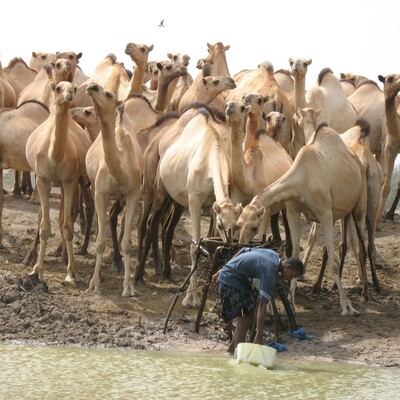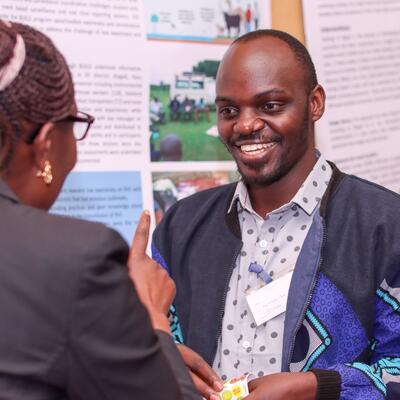
1.5million vaccine doses procured to tackle PPR in Uganda
Uganda’s Ministry of Agriculture, Animal Industry and Fisheries (MAAIF) has procured 1.5 million doses of vaccines valued at about USD 200,000 to support the country response to the Peste des petits ruminants (PPR), a highly contagious and fatal viral disease of sheep and goats. The procurement was supported by PPR Outbreak surveillance data from the Boosting Uganda’s Investment in Livestock Development (BUILD) project. This resource mobilization effort by the government is a great initial effort in helping to contain disease in those areas where it has been reported. It is hoped that the provision of vaccines will incentivize farmers and veterinary officers to continue reporting disease outbreaks.
Globally, PPR causes annual economic losses estimated at US$ 1.5-2 billion. About 65% of the world’s 2 billion sheep and goats are at risk; affecting livelihoods of 300 million poor people. The disease spreads through nose-to-nose contact between infected and non-infected animals, however, there are no known reservoirs in the environment. It mainly affects goat kids and lambs under one year and the clinical signs include nasal discharges, teary eyes and diarrhea.
Uganda is home to over 18 million small ruminants, most of which are found in the cattle corridor, that runs from the North-eastern to the south-western region of the country. 65% of the country’s small ruminant population is found in the Karamoja sub-region, followed by the south western region. In naïve populations, where the disease has never been experienced, an outbreak may result in all the small ruminants being affected by the disease and 90-100% death rates. Animals that suffer from PPR will often die within two weeks, however, those that recover develop lifelong immunity against PPR, reducing the mortality rates in endemic areas like Karamoja to 70-80%.
The procured doses will be rolled out to 38 districts that have suffered or are classified as being at high risk of suffering a PPR outbreak. The vaccines are provided free of charge to the farmers, though transportation to the affected areas is sometimes a challenge. Ring vaccination is usually rolled out following outbreak confirmations to prevent animals in surrounding locations from getting infected. However, this is not always the case, as sometimes vaccines are not available. Poor access to vaccines, often results in farmers resorting to purchase of over-the-counter antibiotics, in the hope that they are treating the disease. Therefore, vaccinating more than one million animals will cushion farmers from devastating losses, especially in areas that are prone to outbreaks; where outbreaks have been confirmed by laboratory testing or at high risk areas at borders.
Uganda’s first PPR outbreak was reported in 2007 in the Karamoja sub-region and is believed to have originated from the Pokot region in Kenya, leading to death of 500,000 sheep and goats valued at US$15 million. A drop in milk production of 2.1 million liters in small ruminants was reported as a result of this outbreak, affecting the livelihoods and food security of a community classified as having the highest poverty incidence in the country. (World Bank Report on Poverty Maps of Uganda, 2018).
Ten years after the 2007 PPR outbreak, outbreaks were reported and confirmed in the central region and later in South- western Uganda, following laboratory tests on samples collected from the respective areas. Prior to this, outbreaks were not being reported either due to lack of disease awareness or limited resources to conduct systematic outbreak investigations. It is also possible that the disease had not spread to some areas, therefore no reports were registered from there.
The increase in the number of outbreaks is attributed to factors such as high density of animals in the areas where outbreaks have been reported; increased movement for purposes such as breeding and trade, etc. as well as the lack of sufficient access to resources and interventions such as vaccines for prevention. This is coupled with lack of knowledge of PPR among farmers, confirmed by absence of a local name for the disease. Cross-border movement of animals has increased the spread of PPR, making it a regional problem, requiring regional interventions.
In Uganda, PPR vaccines are a public good and can therefore only be procured and provided by the central government and distributed through its established systems at the district level. Uganda needs 16million doses to provide complete vaccine coverage of the small ruminants in the country. PPR vaccines are sourced from neighboring countries like Kenya and Botswana. Of the two vaccine options available to farmers in Uganda, one is readily available and commonly used but requires maintenance of a cold chain, making it difficult to distribute to farmers in the remote areas. The second option, which is thermostable and therefore does not require cold chain maintenance is costly because of lyophilization; the process undertaken to package it in powder as opposed to liquid form. This thermostable vaccine has not been used in Uganda before, however, 1 million doses have been procured by the ‘University of Florida project’ - Feed the Future Innovation Lab for Livestock Systems - University of Florida, Institute of Food and Agricultural Sciences - UF/IFAS (ufl.edu) for use in 3 districts of Karamoja region, that is Amudat, Kotido and Kaabong.
Uganda is a signatory to the World Organization for Animal Health (OIE) global partnership program to eradicate PPR from the face of the earth by 2030 https://www.oie.int/en/animal-health-in-the-world/ppr-portal/gsce/ . In a bid to address the PPR challenge, Uganda has developed a draft national PPR control and eradication strategy. The BUILD project supports the national PPR control and eradication strategy through developing a socio-economic framework to assess the impact of PPR interventions. The socio-economic framework looks at how important PPR is to small ruminant farmers compared to other sheep and goat diseases. BUILD is also investigating the possibility of effectively combining two vaccines, in order to reduce the costs that farmers incur in procuring repeated veterinary services. (https://www.galvmed.org/new-sgpppr-combined-vaccine-shows-promise-africa/)
BUILD is updating the epidemiological status of PPR to allow assessment of control options, and assessing capacity development gaps in the implementation of the PPR control and eradication strategy.
In collaboration with MAAIF, Vétérinaires Sans Frontières Germany (VSF-G), the German Federal Research Institute for Animal Health (FLI), the BUILD project supports the government to generate scientific evidence of the existence of PPR in the country, which guides the government vaccine roll-out programme. In 2020, the BUILD PPR team reported 15 outbreaks in various parts of the country, which has motivated additional vaccine procurement by the government.
The collaboration will support and supervise the roll-out of the 1.5 million doses and conduct post vaccination sero-monitoring. The project will provide funds to support the use of one needle per flock, in a bid to promote biosecurity.
To promote appreciation of the extent of the problem, engagements with regional stakeholders have been undertaken. In early 2021, a regional PPR control harmonization meeting (convened by ILRI, funded by GIZ) was held with representatives from BUILD PPR team, MAAIF, Rwanda, Burundi, Kenya, Tanzania and the Democratic Republic of Congo, South Sudan and Ethiopia to map the movement of animals across the different borders.
The data provided by the BUILD PPR team will further support Uganda’s compliance to the OIE PPR eradication strategy and fulfillment of conditions towards being declared a PPR free country. Uganda is at stage one of the four; developing assessment protocols to identify areas where the disease is reported.
Based on the activities conducted and the data collected to far, the following are some of the recommendations from the BUILD PPR team to government through MAAIF;
• Promote vaccination of animals in locations deemed to be at a high risk of PPR outbreaks, even before outbreaks are reported (for instance the cattle corridor).
• Avail resources to investigate outbreaks as soon as they are reported by farmers to mitigate wider spread of the disease.
• Promote regional approaches as PPR is a regional (transboundary) problem. For example, consider jointly mobilizing sources for vaccines as a region.








